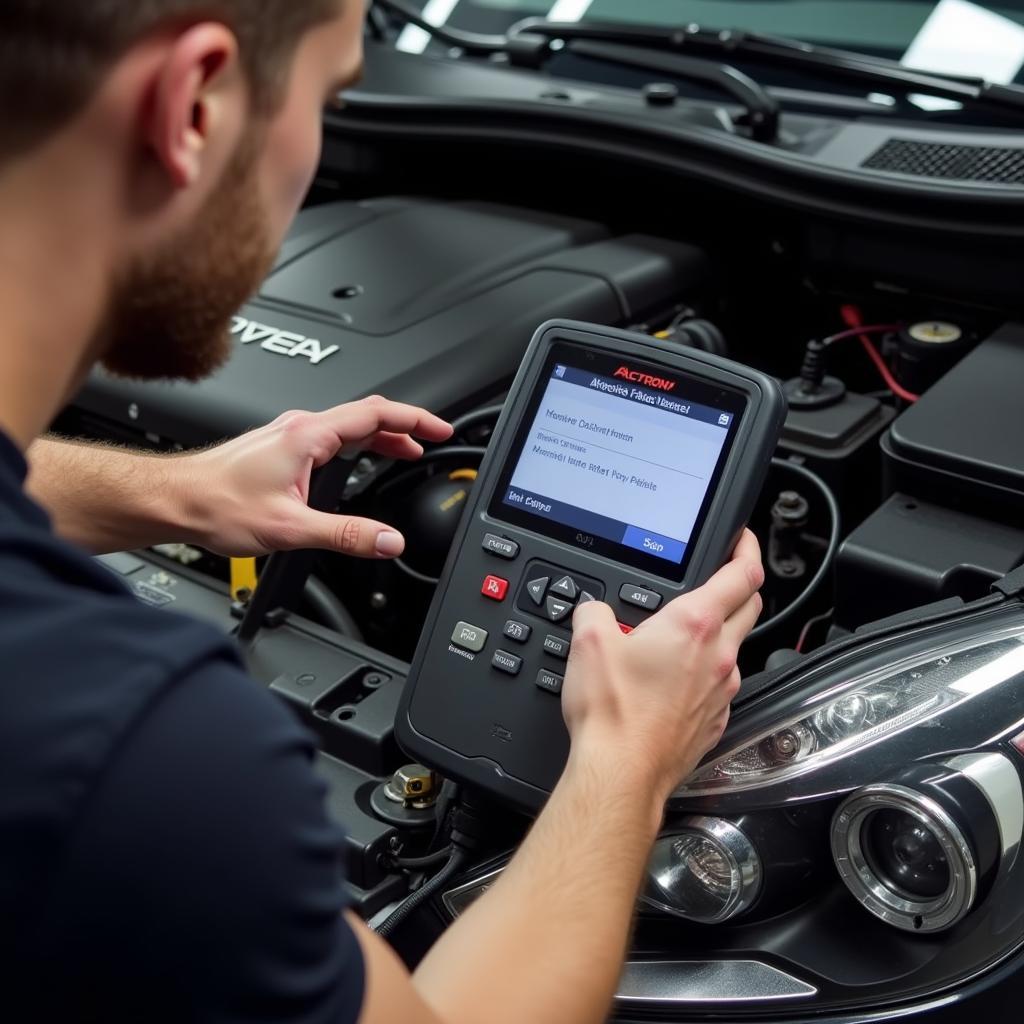Your cart is currently empty!

Understanding Actron OBD2 Auto Scanner Codes
Actron OBD2 auto scanners are essential tools for car owners and mechanics alike. These handy devices plug into your vehicle’s OBD2 port and provide a wealth of information about your car’s engine and emissions systems. However, understanding the codes displayed by your Actron OBD2 scanner can be daunting. This comprehensive guide will demystify those codes and empower you to take control of your car’s health.
What are Actron OBD2 Auto Scanner Codes?
When your car’s computer detects a problem within the engine or emissions systems, it generates a Diagnostic Trouble Code (DTC). These codes are standardized across most vehicles manufactured after 1996. An Actron OBD2 auto scanner reads these codes and displays them on its screen, allowing you to identify the source of the problem.
 Actron OBD2 scanner displaying a code
Actron OBD2 scanner displaying a code
Types of Actron OBD2 Codes
Actron OBD2 scanners display codes in a five-character alphanumeric format. The first character, a letter, indicates the system where the fault originates:
- P: Powertrain (engine, transmission, and associated components)
- B: Body (systems like airbags, power windows, and central locking)
- C: Chassis (components like ABS, steering, and suspension)
- U: Network & Communication (issues with modules and wiring communication)
The second character indicates whether the code is generic (applicable to most vehicles) or manufacturer-specific:
- 0: Generic (standardized by the Society of Automotive Engineers – SAE)
- 1: Manufacturer-specific (unique to the car manufacturer)
The remaining three characters pinpoint the specific area or component related to the fault.
Common Actron OBD2 Auto Scanner Codes
While there are thousands of potential codes, some appear frequently across different vehicle models. Here’s a breakdown of some common Actron OBD2 codes:
Engine-Related Codes (Pxxxx)
- P0101: Mass Air Flow (MAF) Sensor Problem
- P0171: System Too Lean (Bank 1)
- P0300: Random/Multiple Cylinder Misfire Detected
- P0420: Catalyst System Efficiency Below Threshold (Bank 1)
- P0440: Evaporative Emission System Malfunction
 Car engine with diagnostic tool connected
Car engine with diagnostic tool connected
Oxygen Sensor Codes (P0130-P0167)
- P0135: Oxygen Sensor Heater Circuit Malfunction (Bank 1, Sensor 1)
- P0131: O2 Sensor Circuit Low Voltage (Bank 1 Sensor 1)
- P0155: O2 Sensor Heater Circuit Malfunction (Bank 2, Sensor 1)
Misfire Codes (P030x)
- P0301: Cylinder 1 Misfire Detected
- P0302: Cylinder 2 Misfire Detected
- P0303: Cylinder 3 Misfire Detected
What to Do When You Get an Actron OBD2 Code
- Don’t Panic: Seeing a code doesn’t always mean your car is about to break down.
- Record the Code: Write down the exact code displayed on your Actron scanner.
- Research the Code: Consult online resources, repair manuals, or contact a mechanic to understand the code’s meaning.
- Inspect for Obvious Issues: Check for loose connections, damaged wires, or other visible problems.
- Consider DIY Repairs: If you’re mechanically inclined and the issue seems straightforward, you might be able to address it yourself. Always consult reliable repair information before attempting any repairs.
- Consult a Professional: If you’re unsure about the diagnosis or repair, it’s best to seek help from a qualified mechanic.
 Mechanic using an OBD2 scanner on a car
Mechanic using an OBD2 scanner on a car
Conclusion
Actron OBD2 auto scanners are invaluable tools for diagnosing car problems. By understanding the codes they display, you can gain valuable insights into your vehicle’s health and make informed decisions about maintenance and repairs. Remember, while this guide provides a starting point, consulting a trusted mechanic is always recommended for complex issues.

Leave a Reply